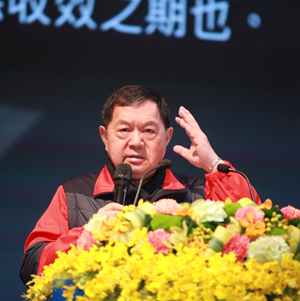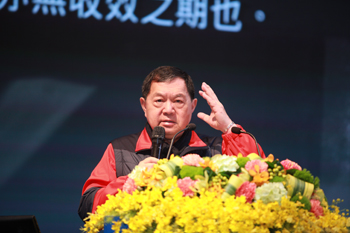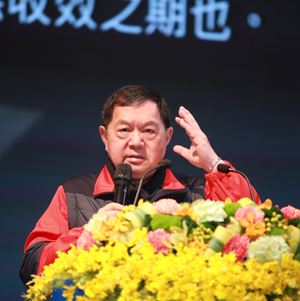2018年01月號 领航者的话
Chairman’s Message at 2017 Far Eastern Group Summit INNOVATION, TRANSFORMATION, RESTRUCTURE; For Now / Tomorrow
Far Eastern Group / Douglas Hsu


Aside from reflecting on milestones that the Far Eastern Group has achieved in 2017, we will revisit the Group’s past growth roadmap, then plan on how to embrace the future deliberately, and focus on the three major points of this year’s Summit: Innovation, Transformation, and Restructure, enabling the Group to achieve the next high peak.
1.2017 Milestones
The Far Eastern Group registered excellent performance in 2017. Far EasTone Telecom, SOGO Department Stores, and Far Eastern Department Stores, all celebrated their 20th, 30th and 50th anniversaries, respectively. They plan to bring more refreshing consumer experience in the future. In the cement sector, Asia Cement now ranks among top 10 in China and will expedite on merger and acquisition to expand its scale. Additionally, Far Eastern Toll Collection established FETC International Co., Ltd. to assist the expansion of smart transportation abroad and make diplomatic contributions. ETC’s gigantic big database will help it in research and future application of big data. On the e-commerce side, FriDay and GoHappy have merged as Yuan Shi Digital Technology to integrate the Group’s e-commerce and m-commerce operations. Many new enterprises have launched their new services, such as Ya Tung Ready-Mixed Concrete and U-Ming Marine Transport developed their new posts and new vessels. Far Eastern International Bank opened its Intelligent Branch on the 13th floor of Taipei Metro, the Group Headquarters. Happycash expanded its online services, hopefully to reach its target of a cashless society. Furthermore, to cope with the coming of aging society, Far Eastern Memorial Hospital established the first Alzheimer’s Disease Joint Care Center in New Taipei City. On the environmental side, Asia Cement Hsinchu Offshore Wind Power Project has passed the preliminary review on the environmental impact, a big step into energy transformation. On the smart manufacturing side, Oriental Petrochemical began its operations of the second smart factory, which will significantly improve its competitiveness. In the foreseeable future, we hope to strengthen our horizontal collaborations, continue organic growth, and provide more convenient services to our consumers.
2.Growth Roadmap
While reflecting back on the Group’s major achievements, each leader should properly prepare for the future. The Far Eastern Group has been operating in Taiwan for over 68 years. Our growth could be divided into three phases: the first phase (the first 20 years) was focused on developing the three core businesses of textiles, cement, and retail. The second phase (from 1970 to 2000) was extended into petrochemical, transportation, hotel, banking, and telecom industries. The third phase (after the 21st century) was to continue to expand investments overseas, as well as launching e-commerce, intelligent transportation, green business…etc. The nearly 70 years of developments of the FEG has marked a history of continuous innovative growth. In responding to the fast-paced environment, our growth has also to be faster, coupled with the diversification of different industries, the growth will no longer be merely 5%, 6%, but exponentially to 20%, 30%, or even double. Thus, how to expand operations and transform into new territories is the Group’s future objective.
Textile business, the earliest establishment within our Group, has performed well by seizing the right direction despite being in a traditional industry, we could look forward to a bright future. From 1980 to 2030, global fibers in particular polyester production has been growing tremendously. Therefore, Far Eastern New Century (FENC) should strive to expand its application into food packaging, industrial packaging, medical field, etc. Not only the polyester and synthetic fiber business, but also cement and retail industries, they should think more thoroughly and focus on diversified applications to accelerate expansion.
On the other hand, we should also pay attention to the environmentally sustainable production, in particular given the limited resources on the planet, how to produce in a more environmentally friendly way. Since 2012, FENC has continued to bring in waterless dyeing equipment and digital textile printing technology to conserve energy and cut down industrial waste.
In line with smart technologies, FENC has begun to integrate textile products with state-of-the-art technologies to greatly enhance the traditional heating and fashionable functions into a new level.
In other words, the Group’s future depends on exploring new products, applying new technologies, and combining new business models under environmental sustainability to create the new future.
3.Innovation
During the past few years, some enterprises, while working diligently, did not deliver significant outcome. This is just like a hamster running endlessly in wheels without achieving anything. We should examine more deeply that have the business model, products/services, or even customers changed or remained the same in the past five to ten years? The world is changing so fast, in order to escape from red ocean competition, we must innovate our business models. And the four components of business models are to define: “Who” are the target customers? “What” to sell? “How” to produce? and “Why” it’s profitable?
Long-term competitive edge lies upon the ability to keep creating new business models. Creative iteration is one of the ways to innovate. We need to broaden our vision, seek possible operating models from other industries, learn their know-hows, and adopt their success factors. Each department should think through together, make adjustment, and then apply to our own industries. The following six successful business models are provided for your reference:
1. Razor and Blade: Sell the basic merchandise at an affordable price, but need to match with more expensive accessories. For example, the razor of Gillette is not very costly, but the frequently changed blades are sold at higher price.
2. Leverage Customer Data: After collecting customer data, analyze and apply or sell the data to other business operators, and create maximum value. Current technology industry leaders such as Amazon, Google, and Facebook are experts in this field.
3. Direct Selling: Business model of direct selling is to skip the middlemen and face directly with customers, which can not only saves channeling cost, but also seizes real- time feedback. Even though direct selling has existed long before, recently the global direct selling market continues to grow; Amway and Avon are renowned brands.
4. Lock-in: Heighten customers’ transfer cost to increase stickiness. For example, Microsoft locked in office software with its operating system, and consumers who purchase Nestle Nespresso coffee machine must also buy use Nespresso capsules to go with it.
5. Self-service: Offer customers ‘self-service’ to lower operating cost and cut down price. McDonald and IKEA have adopted similar practices.
6. Two-sided Market: Through middle platform to assist complimentary two-sided market. For example, eBay is the online transaction platform connecting buyers and sellers, and Airbnb connects tenants with rental needs and owners with empty house or rooms.
It is worth noting that the innovation of business model cannot be accomplished instantly, but must proceed with solid steps by analyzing the current ecosystems, realigning business models, executing pilot testing, then readjusting and optimizing. “Just do it.”

Artificial Intelligence (AI) is a system that can detect its environment and respond independently. While current AI can only solve problems in specific areas (such as AlphaGo has turned into a world chess champion, but it cannot drive, move or sweep,) its application has appeared in the daily lives including Google’s voice translation, traffic route planning, intelligent assistant, intelligent home system, etc. Enterprises have also been trying to use warehouse robots, logistic Unmanned Aerial Vehicle (UAV), and FinTech to develop new business models.
According to PwC’s survey on the application of AI for global CEO, it indicates that 24% of the enterprises have incorporated AI into their operations. More than 50% of enterprises is actively evaluating or learning about it, illustrating the impact on the industry is spreading quickly.
With regard to FinTech, Ant Financial of Alibaba Group ranked top on the global Fintech 100 list for 2016 selected by KPMG. Ant Financial also operates Yu’ebao, Sesame Credit, Ant Fortune, personal credit, and wealth management services. Now the Far Eastern Group’s financial businesses have just initiated the application of AI, and would need to speed up in order to keep pace.
In the manufacturing side, BASF, the world’s largest chemical group launched “BASF 4.0” project in 2015 to fully engage in digitalization and initiate smart manufacturing, smart supply chain, digitized business model, and smart R&D innovation. In addition, half of the Far Eastern Group’s manufacturing facilities should also speed up on the implementation of smart manufacturing (i.e. Industry 4.0) to elevate production, control quality, lower maintenance loss, and connect with upper and down-stream supply chains to increase the competitiveness.
To retail industry, traditional retailers have accumulated big data comprising customer information, shopping details, sales space information, etc. In the future, we can apply AI to elevate operating efficiency, through machine learning and integration of retailer membership system to complete customized retail services and consumer needs forecast, and adjust inventory flexibly. The analytics of the computer visual system may help optimize the in-store merchandise display, confirm customer memberships, and even complete self-check transactions; AI robotics can play an important role in retail businesses to help elevate turnover and accuracy of warehouse and logistics, and lower labor cost. There is an immense retail group under our flag, however the current adoption of AI is not sufficient, while other retailers have been eagerly embracing the application of AI, we should also follow up quickly.
According to Dr. Kai-fu Lee’s book, “Here Comes AI,” it states that in the next 10 years, occupations such as accountants, security guards, assistants, will be eliminated or transformed since they can make decisions and respond within 5 seconds. For the enterprises, if competitors assign these tasks for AI to handle, they can reduce cost and improve efficiency significantly. Therefore, we should not only push for the implementation of AI, but also need to think about how to help colleagues transfer their skill sets to collaborate with AI.
Furthermore, Internet of Things (‘IoT’) is fundamental for AI. Some businesses in the Group were already behind in the era of IoT, now must add AI in order to stay competitive.
5.Restructure
Peter Drucker once said: “Culture eats strategy for breakfast.” Corporate culture will affect execution of business strategies. If the executives driving the strategies are not passionate about the change, or are apathetic to their job and to their organizations, then you stand no chance to implement it successfully. Far Eastern Group has a wonderful culture. Each company also has its own culture, which has set solid foundation for who we are today. Yet the culture should also evolve with time to stay with present dynamics.
“Silo Effect” is a negative culture that should be eradicated. It will erode the corporation’s competitive niche, devour company’s energy, and this generally exists across every organization. No matter which professions (accounting, personnel, sales, production, etc.), areas (Taipei, Kaohsiung, Shanghai, Chengdu, etc.), product categories (consumables, durables) or customers (large corporations, medium- & small-enterprises, consumers, etc.), if each unit withholds information, the organization will be filled with various information silos, leading to internal competitions, hinder the abilities to innovate, and damage the competitive edge.
Therefore, we should reassess and restructure each company’s organizational structures to stay with the changing customer needs, and engage in innovative business model, elevate the information sharing across organizations, enhance operation efficiencies, and embrace the developments of smart technologies (ie. IoT and AI.)
6.Conclusion
While the theme of today’s topic is “Innovation, Transformation, Restructure,” there is only one core value - “Change” because the only thing that is constant is change. We must continue to change and cannot stop by just trying a little. Moreover, mindset determines everything. Growth mindset means willingness to strive, learn and constantly seek for improvements. On the contrary, fixed mindset means unwillingness to improve or make breakthrough. Facing the mounting relentless challenges under the dynamic environments, we need more staff, organizations, and leaders with growth mindset.
In the past, the Group has delivered remarkable results. The future is in every Far Easterner’s hands. With faith and strong confidence, we will complete transformation successfully.#



















